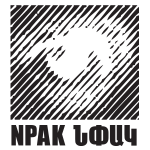The Swiss artist Silas Heizmann (*1990) is the second artist to participate in the international artists’ exchange program initiated by Foundation KulturDialog Armenien and organized in coopera-tion with Christoph Merian Stiftung Basel (Atelier Mondial), Switzerland, and the Cultural Office of the City of Freiburg in Breisgau, Germany. Thanks to this program, the freelance artist from Basel, Switzerland, is given the chance to live and work as artist-in-residence in Armenia for six months.
Heizmann studied at the Academy of Art and Design in Basel (Switzerland) and at the Academy of Fine Arts in Leipzig (Germany). Besides his creative works as an artist, he also works as a graphic designer and in the field of screen printing. Additionally, he is active as a lecturer. In his works, Heizmann reflects upon changes and turning points within urban environment and also in people’s social life. Architecture and its promises, emptiness, pop culture, longing and protest are sources of inspiration for his art. Thanks to various and changing means of expression, he presents objects in a context which deprives them of their unequivocal function, but which then, at the same time, opens a space between the genres of documentary and fiction.
As a Swiss citizen, Heizmann grew up in a country in which public opinion is formed traditionally by public broadcasting institutions. But those institutions have troubles with keeping up with the ways and the speed of how information is spread today. Consequently, generations drifted apart in terms of how media is used and consumed, how information is spread and as to the question of how to discuss social events and how to perceive them. Heizmann is part of a new generation of media consumers, who prefer to search information on the internet themselves and to gather the information of their choice on social media platforms.
During his six months residency in Yerevan, Heizmann dealt with the character of media reports, especially in the context of the events in Armenia in July 2016. Directly linked to those events, was the media’s fight for the one and only valuable interpretation. It became more than evident that public media and independent internet portals gave proof of important discrepancies concerning the interpretation of those events, which Heizmann makes the subject of discussion in his solo exhibition at ACCEA.
The exhibition’s title “THERE WILL BE NO SLOW MOTION OR STILL LIFE” serves as the basis for the concept of the works in Heizmann’s exhibition. By choosing this phrase, Heizmann refers to a line in a song by the American musician and poet Gil Scott-Heron (1929-2011). He is regarded as the forerunner of hip-hop and rap music. On his debut album (1970), Scott-Heron put into music the poem entitled “The Revolution will not be televised”, considered today as one of his most important songs. In this song, the musician criticises the American consumer behaviour of the time, using diverse slogans from television and other popular media. The musician calls upon his listeners to free themselves from their passive, media consuming role: As long as people remain passive consumers sitting in front of the television, there will be no revolution.
Heizmann transfers this question and its inherent critique to the present day: He uses the genre of still life to point at the level of inconsistency in information provided by public and by international and independent media. Integrated in a still life, the artist put a smartphone showing protest videos via YouTube live stream. Those videos are accompanied by an instrumental version of the famous song by Scott-Heron to which the exhibition refers to in terms of content. The new interpretation of this song was composed by the Swiss producer Gidon Schvitz (Basel) and has been commissioned specially for this exhibition.






















